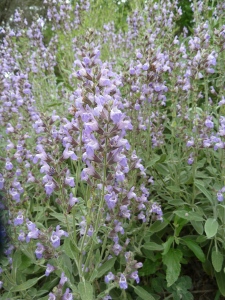Have you ever grown anything specifically with wild birds in mind? Many people plant things like thistle, cone flower, rose and various berries specifically to invite their feathered friends to grab a snack as they’re passing through. Even if you’re not a bird watcher (or “birder”) it is definitely nice to have the flit of movement across your vision in the dead cold of winter. We are often seasonally visited by juncos, ceder waxwings and Boreal chickadees, and the cardinals, gold finches and blue jays rarely leave for the winter.
I have always made sure there were plenty of prickly seeds and squishy berries for the little guys, but it wasn’t until this year that I decided to try growing so of my own birdseed to put up for winter.Of course, I’ve grown sunflowers in the past, but the chickadees and finches always managed to pluck all of the tiny morsels from their seats before I was able to bring them in to dry for the winter (this year I did manage to get a few, though!)

Millet. It’s a humble grain, often forgotten, and it has to be one of the easiest things I’ve ever grown. In fact, prior to this year I had been pulling it out of the flower beds in a futile and tangled war between myself and those-things-I-used-to-call-weeds. This year I decided that as long as it wasn’t killing anything else with it’s unruly sprawl, I would leave the volunteer army of millet in various places in the garden.
It isn’t a small plant, mind you. The one I have out front is more than six feet tall and sprawls roughly four feet in diameter, but it is a beautiful plant to see nodding it’s heavy, sleepy seed heads in the late summer breeze. This morning I began cutting the largest of the seed heads and drying them. For now I’ll be drying them in our kitchen, but as the season progresses I’ll be moving the millet and sunflowers to the barn to hang where they will season until the birds need them most: the dead of winter.
Mil let is not a particularly palatable grain for birds, but it does provide protein and vital energy for them in the cold shivery months. The way I have always fed it is mixed with a bit of sunflower seed to encourage them to try it. Once they realize that it’s a source of food, despite not being terribly tasty, they are on the feeders regularly as soon as the wild sources of food run out.
let is not a particularly palatable grain for birds, but it does provide protein and vital energy for them in the cold shivery months. The way I have always fed it is mixed with a bit of sunflower seed to encourage them to try it. Once they realize that it’s a source of food, despite not being terribly tasty, they are on the feeders regularly as soon as the wild sources of food run out.
The one thing I try to do above all else is keep the feeders full during the winter. The birds that come to your feeders are there specifically because there is a food source. If the food source stops, they move on, but they don’t always make it to the next food source, especially in some of the nasty Michigan weather we get up here.
I’m sure I’ll be buying birdseed from the store this winter (many stores sell it in bulk and you can bring your own containers!) but I’ll also be supplementing with what I’ve grown. If you have the space for it, give it a shot. This year my millet required absolutely no extra effort at all, except to cut it and hang it to dry. Planting it was simple – in most cases the birds took care of that for me. If I really wanted to plant a patch, I’d just scratch up the dirt a bit and sprinkle it with millet seeds. It’s a pretty intense little booger, so once you grow it plan to have it around for years to come.
Next year I plan to try a few other bird seeds as well as some millet for our own personal use. I did plant some sorghum this spring, but its long season requirements might mean it doesn’t finish developing before it conks out for the year. Ah well. The point is, while you’re putting up food for yourself this fall, considering putting some up for the feathered folk as well!
Have you ever grown your own wild bird seed? Which varieties have you grown?
Want to read more from Tanglewood Farm? Check out Emily’s blog over at A Pinch of Something Nice where she writes about her experiences with her gardens, her livestock and her leased historical home in SE Michigan.
Read Full Post »




























